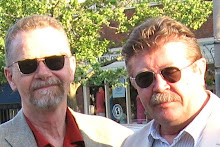
THEATRE REVIEW: HEARTBREAK HOUSE
26 MAY/11
JOHN COULBOURN,
QMI Agency
Rating: 4 out of 5
NIAGARA-ON-THE-LAKE — It takes a lot of resourcefulness (and a certain amount of cheek) to stage a compelling production of a play that was written almost a century ago to tell us that the end of civilization was at hand. I mean, here we are a century later and civilization is certainly changed, but still going strong even if it still teeters on the edge of the abyss.
None of which stands in the way of director Christopher Newton, tasked as he is with directing a production of Bernard Shaw’s HEARTBREAK HOUSE to launch the 50th season of the Shaw Festival, where he once served as artistic director. Newton’s cheeky, sometimes compelling and almost always resourceful production launched the season Wednesday on the stage of the Festival Theatre.
Written and set in England on the cusp of the War To End All Wars, HEARTBREAK HOUSE (which didn’t première ’til after the First World War) is certainly a mammoth theatrical beast — three hours of droll and often dolorous Shavian wit and wisdom. It takes place in the Sussex home of the eccentric Captain Shotover (Michael Ball), a crusty retired sea captain who shares his strangely nautically themed home with his youngest daughter Hesione (Deborah Hay) and her swashbuckling husband, Hector Hushabye (Blair Williams).
As the play begins, Hesione’s dear friend Ellie Dunn (Robin Evan Willis) has arrived for a visit, the unstated purpose which is to give Hesione the time to talk her friend out of a loveless but lucrative marriage to the soulless Boss Mangan (Benedict Campbell), a captain of British industry. Before that can be accomplished however, the captain’s oldest daughter, Ariadne (Laurie Paton) returns to a family fold she abandoned years ago to take up a more conventional life as Lady Underwood. In her wake, she trails her besotted brother-in-law Randall (played by Patrick Galligan).
Every character arrives loaded down with Shaw’s baggage, charged with illuminating his bleak if often funny vision of the world, even while they get on with their self-centred lives. Working on a fussy but effective set created by designer Leslie Frankish and lit by Kevin Lamotte, Newton stages the work with a kind of brittle, self-aware style usually reserved for the works of Coward, relying not on the arc of Willis’ character but rather on Ball (in that full curmudgeon mode that has become his stock-in-trade) to anchor things with a heavy dollop of pragmatic humanity. And it works. Until it doesn’t, of course.
As the house party wears on (and on) and the characters strip away layer after layer of pretense — laying waste to everything from marriage and the relationship of the sexes to capitalism, politics and even good old fashioned horse-sense — the intent is to reveal the heartbreak that informs each sad and empty life. But though Newton draws memorable work from many of his cast-members — Hay, Paton and Williams are all delicious, as is Galligan in melt-down mode, although Campbell adds too much fibre to his diet chewing on the scenery on occasion — when it comes to the pivotal final act in which all the heartbreak is finally laid bare, he falters.
In stripping away the layers of this particular Shavian onion — some disturbingly relevant almost a century later — to get to its heart, he discovers nothing there. Instead of a bleak vision of an impending Armageddon, this production seems to suggest that thanks to an innate inability to muddle through, there will indeed always be an England.
And that’s fair enough. As recent events prove, you can only promise the imminent end of the world for so long before you have to change your tune.




No comments:
Post a Comment